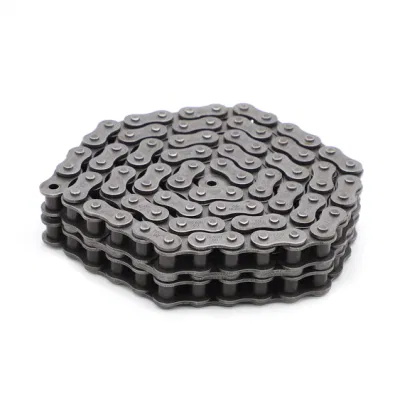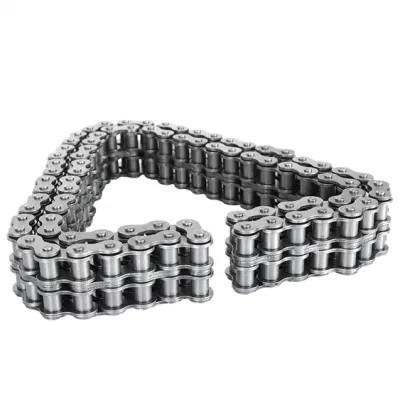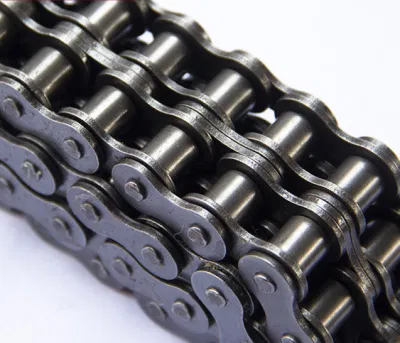Product Description
A Series Short Pitch Precision Triplex Roller Chains & Bush Chains
| ISO/ANSI/ DIN Chain No. |
Chain No. | Pitch P mm |
Roller diameter
d1max |
Width between inner plates b1min mm |
Pin diameter
d2max |
Pin length | Inner plate depth h2max mm |
Plate thickness Tmax mm |
Transverse pitch Pt |
Tensile strength
Qmin |
Average tensile strength Q0 kN |
Weigth per meter q kg/m |
|
| Lmax mm |
Lcmax mm |
||||||||||||
| 160-3 | 32A-3 | 50.800 | 28.58 | 31.55 | 14.27 | 181.8 | 186.6 | 47.80 | 6.40 | 58.55 | 680.4/154636 | 800.7 | 30.02 |
ROLLER CHAIN
Roller chain or bush roller chain is the type of chain drive most commonly used for transmission of mechanical power on many kinds of domestic, industrial and agricultural machinery, including conveyors, wire- and tube-drawing machines, printing presses, cars, motorcycles, and bicycles. It consists of a series of short cylindrical rollers held together by side links. It is driven by a toothed wheel called a sprocket. It is a simple, reliable, and efficient means of power transmission.
CHAIN STRENGTH
The most common measure of roller chain’s strength is tensile strength. Tensile strength represents how much load a chain can withstand under a one-time load before breaking. Just as important as tensile strength is a chain’s fatigue strength. The critical factors in a chain’s fatigue strength is the quality of steel used to manufacture the chain, the heat treatment of the chain components, the quality of the pitch hole fabrication of the linkplates, and the type of shot plus the intensity of shot peen coverage on the linkplates. Other factors can include the thickness of the linkplates and the design (contour) of the linkplates. The rule of thumb for roller chain operating on a continuous drive is for the chain load to not exceed a mere 1/6 or 1/9 of the chain’s tensile strength, depending on the type of master links used (press-fit vs. slip-fit)[citation needed]. Roller chains operating on a continuous drive beyond these thresholds can and typically do fail prematurely via linkplate fatigue failure.
The standard minimum ultimate strength of the ANSI 29.1 steel chain is 12,500 x (pitch, in inches)2. X-ring and O-Ring chains greatly decrease wear by means of internal lubricants, increasing chain life. The internal lubrication is inserted by means of a vacuum when riveting the chain together.
CHAIN STHangZhouRDS
Standards organizations (such as ANSI and ISO) maintain standards for design, dimensions, and interchangeability of transmission chains. For example, the following Table shows data from ANSI standard B29.1-2011 (Precision Power Transmission Roller Chains, Attachments, and Sprockets) developed by the American Society of Mechanical Engineers (ASME). See the references[8][9][10] for additional information.
ASME/ANSI B29.1-2011 Roller Chain Standard SizesSizePitchMaximum Roller DiameterMinimum Ultimate Tensile StrengthMeasuring Load25
| ASME/ANSI B29.1-2011 Roller Chain Standard Sizes | ||||
| Size | Pitch | Maximum Roller Diameter | Minimum Ultimate Tensile Strength | Measuring Load |
|---|---|---|---|---|
| 25 | 0.250 in (6.35 mm) | 0.130 in (3.30 mm) | 780 lb (350 kg) | 18 lb (8.2 kg) |
| 35 | 0.375 in (9.53 mm) | 0.200 in (5.08 mm) | 1,760 lb (800 kg) | 18 lb (8.2 kg) |
| 41 | 0.500 in (12.70 mm) | 0.306 in (7.77 mm) | 1,500 lb (680 kg) | 18 lb (8.2 kg) |
| 40 | 0.500 in (12.70 mm) | 0.312 in (7.92 mm) | 3,125 lb (1,417 kg) | 31 lb (14 kg) |
| 50 | 0.625 in (15.88 mm) | 0.400 in (10.16 mm) | 4,880 lb (2,210 kg) | 49 lb (22 kg) |
| 60 | 0.750 in (19.05 mm) | 0.469 in (11.91 mm) | 7,030 lb (3,190 kg) | 70 lb (32 kg) |
| 80 | 1.000 in (25.40 mm) | 0.625 in (15.88 mm) | 12,500 lb (5,700 kg) | 125 lb (57 kg) |
| 100 | 1.250 in (31.75 mm) | 0.750 in (19.05 mm) | 19,531 lb (8,859 kg) | 195 lb (88 kg) |
| 120 | 1.500 in (38.10 mm) | 0.875 in (22.23 mm) | 28,125 lb (12,757 kg) | 281 lb (127 kg) |
| 140 | 1.750 in (44.45 mm) | 1.000 in (25.40 mm) | 38,280 lb (17,360 kg) | 383 lb (174 kg) |
| 160 | 2.000 in (50.80 mm) | 1.125 in (28.58 mm) | 50,000 lb (23,000 kg) | 500 lb (230 kg) |
| 180 | 2.250 in (57.15 mm) | 1.460 in (37.08 mm) | 63,280 lb (28,700 kg) | 633 lb (287 kg) |
| 200 | 2.500 in (63.50 mm) | 1.562 in (39.67 mm) | 78,175 lb (35,460 kg) | 781 lb (354 kg) |
| 240 | 3.000 in (76.20 mm) | 1.875 in (47.63 mm) | 112,500 lb (51,000 kg) | 1,000 lb (450 kg |
For mnemonic purposes, below is another presentation of key dimensions from the same standard, expressed in fractions of an inch (which was part of the thinking behind the choice of preferred numbers in the ANSI standard):
| Pitch (inches) | Pitch expressed in eighths |
ANSI standard chain number |
Width (inches) |
|---|---|---|---|
| 1⁄4 | 2⁄8 | 25 | 1⁄8 |
| 3⁄8 | 3⁄8 | 35 | 3⁄16 |
| 1⁄2 | 4⁄8 | 41 | 1⁄4 |
| 1⁄2 | 4⁄8 | 40 | 5⁄16 |
| 5⁄8 | 5⁄8 | 50 | 3⁄8 |
| 3⁄4 | 6⁄8 | 60 | 1⁄2 |
| 1 | 8⁄8 | 80 | 5⁄8 |
Notes:
1. The pitch is the distance between roller centers. The width is the distance between the link plates (i.e. slightly more than the roller width to allow for clearance).
2. The right-hand digit of the standard denotes 0 = normal chain, 1 = lightweight chain, 5 = rollerless bushing chain.
3. The left-hand digit denotes the number of eighths of an inch that make up the pitch.
4. An “H” following the standard number denotes heavyweight chain. A hyphenated number following the standard number denotes double-strand (2), triple-strand (3), and so on. Thus 60H-3 denotes number 60 heavyweight triple-strand chain.
A typical bicycle chain (for derailleur gears) uses narrow 1⁄2-inch-pitch chain. The width of the chain is variable, and does not affect the load capacity. The more sprockets at the rear wheel (historically 3-6, nowadays 7-12 sprockets), the narrower the chain. Chains are sold according to the number of speeds they are designed to work with, for example, “10 speed chain”. Hub gear or single speed bicycles use 1/2″ x 1/8″ chains, where 1/8″ refers to the maximum thickness of a sprocket that can be used with the chain.
Typically chains with parallel shaped links have an even number of links, with each narrow link followed by a broad one. Chains built up with a uniform type of link, narrow at 1 and broad at the other end, can be made with an odd number of links, which can be an advantage to adapt to a special chainwheel-distance; on the other side such a chain tends to be not so strong.
Roller chains made using ISO standard are sometimes called as isochains.
WHY CHOOSE US
The 219 sets of advanced automatic production equipment provide guarantees for high product quality. The 167 engineers and technicians with senior professional titles can design and develop products to meet the exact demands of customers, and OEM customizations are also available with us. Our sound global service network can provide customers with timely after-sales technical services.
We are not just a manufacturer and supplier, but also an industry consultant. We work pro-actively with you to offer expert advice and product recommendations in order to end up with a most cost effective product available for your specific application. The clients we serve CHINAMFG range from end users to distributors and OEMs. Our OEM replacements can be substituted wherever necessary and suitable for both repair and new assemblies.
Our Company Certifications
Safe Package and Shipment
Q:Why choose us ?
A. we are a manufacturer, we have manufactured valve for over 20 years .
B. Reliable Quality Assurance System;
C. Cutting-Edge Computer-Controlled CNC Machines;
D. Bespoke Solutions from Highly Experienced Specialists;
E. Customization and OEM Available for Specific Application;
F. Extensive Inventory of Spare Parts and Accessories;
G. Well-Developed CHINAMFG Marketing Network;
H. Efficient After-Sale Service System
Q. what is your payment term?
A: 30% TT deposit, 70% balance T/T before shipping.
Q:Can we print our logo on your products?
A: yes, we offer OEM/ODM service, we support the customized logo, size, package,etc.
Q: Can you make chains according to my CAD drawings?
A: Yes. Besides the regular standard chains, we produce non-standard and custom-design products to meet the specific technical requirements. In reality, a sizable portion of our production capacity is assigned to make non-standard products.
Q: what is your main market?
A: North America, South America, Eastern Europe, Western Europe, Southeast Asia, Africa, Oceania, Mid East, Eastern Asia,
Q: Can I get samples from your factory?
A: Yes, Samples can be provided.
Q: If products have some quality problem, how would you deal with?
A: We will responsible for all the quality problems.
/* January 22, 2571 19:08:37 */!function(){function s(e,r){var a,o={};try{e&&e.split(“,”).forEach(function(e,t){e&&(a=e.match(/(.*?):(.*)$/))&&1
| Standard or Nonstandard: | Standard |
|---|---|
| Application: | Textile Machinery, Garment Machinery, Conveyer Equipment, Packaging Machinery, Electric Cars, Motorcycle, Food Machinery, Mining Equipment, Agricultural Machinery, Car, Textile Machinery, Garment Machinery |
| Surface Treatment: | Polishing |
| Structure: | Roller Chain |
| Material: | Alloy |
| Type: | Derrick, Bush Chain |
| Samples: |
US$ 0/Meter
1 Meter(Min.Order) | |
|---|
| Customization: |
Available
| Customized Request |
|---|

What are the safety precautions when working with bush chains?
Working with bush chains requires adherence to certain safety precautions to ensure the well-being of operators and prevent accidents. Here are some important safety measures to consider:
1. Personal protective equipment (PPE): Operators should wear appropriate PPE, including safety glasses, gloves, and protective clothing, to protect themselves from potential hazards such as flying debris, pinching, or entanglement.
2. Training and knowledge: Operators should be properly trained in the operation and maintenance of bush chains. They should have a thorough understanding of the equipment, including its components, functions, and potential hazards. Training should cover safe operating procedures, including start-up, shutdown, and emergency procedures.
3. Lockout/tagout procedures: Before performing any maintenance or repair work on a bush chain, proper lockout/tagout procedures should be followed. This involves isolating the power source, de-energizing the equipment, and securing it with lockout devices or tags to prevent accidental startup.
4. Regular inspections: Regular inspections should be conducted to identify any signs of wear, damage, or misalignment in the bush chain. This includes checking for loose bolts, worn sprockets, damaged links, or any other issues that could compromise the chain’s integrity. Any identified problems should be promptly addressed to prevent further damage or accidents.
5. Proper lifting and handling: When handling bush chains, proper lifting techniques should be employed to prevent strain or injury. Chains should be lifted using appropriate lifting equipment, and operators should avoid placing themselves in a position where they could be caught between moving parts.
6. Clean and well-maintained work environment: The work area should be clean, well-lit, and free from clutter or obstructions. This ensures that operators have clear visibility and can safely access the bush chain without tripping or other hazards.
7. Follow manufacturer guidelines: It is important to follow the manufacturer’s guidelines and recommendations for the safe use, maintenance, and inspection of the specific bush chain being used. This includes following recommended lubrication practices, tensioning guidelines, and any other instructions provided by the manufacturer.
By adhering to these safety precautions, operators can mitigate potential risks associated with working with bush chains and ensure a safe working environment for themselves and others involved in the operation and maintenance of the equipment.

Can a bush chain be retrofitted into an existing system?
Yes, a bush chain can be retrofitted into an existing system in many cases. Retrofits are common when there is a need to upgrade or replace the existing chain with a more efficient or higher-quality option. The process of retrofitting a bush chain typically involves the following steps:
1. Evaluation of the existing system: The first step is to assess the existing system and determine if a bush chain can be installed. Factors such as space availability, compatibility with existing components, and load requirements need to be considered.
2. Selection of the appropriate bush chain: Once the system has been evaluated, the next step is to select the appropriate bush chain for the retrofit. This involves considering factors such as pitch, size, strength, and material compatibility to ensure a proper fit and optimal performance.
3. Modification of the system: Depending on the design of the existing system, some modifications may be required to accommodate the bush chain. This could involve adjusting the sprockets, modifying the chain guides, or making other necessary changes to ensure proper alignment and tensioning.
4. Installation of the bush chain: Once the modifications have been made, the bush chain can be installed into the existing system. This typically involves removing the old chain and replacing it with the new bush chain. Proper tensioning and alignment should be ensured during the installation process.
5. Testing and adjustments: After the bush chain is installed, it is important to conduct thorough testing to ensure proper operation. This includes checking for smooth movement, correct tension, and proper engagement with the sprockets. Any necessary adjustments should be made to optimize performance.
It is important to note that the feasibility of retrofitting a bush chain into an existing system depends on the specific requirements and design of the system. In some cases, additional modifications or adaptations may be needed to ensure compatibility and performance. Consulting with a qualified engineer or chain manufacturer can help determine the best approach for retrofitting a bush chain into an existing system.

How do you select the right bush chain for your application?
Choosing the right bush chain for your application is essential to ensure optimal performance and longevity. Here are some factors to consider when selecting a bush chain:
1. Load Capacity: Evaluate the maximum load that the chain will need to transmit. Consider factors such as weight, acceleration, and shock loads. Choose a bush chain with a load capacity that exceeds the anticipated load to ensure reliable operation.
2. Speed: Determine the operating speed of the chain. Higher speeds may require chains with specialized designs to minimize wear, reduce friction, and maintain accurate timing.
3. Environmental Conditions: Assess the environmental conditions in which the chain will operate. Consider factors such as temperature, humidity, dust, chemicals, and exposure to corrosive substances. Select a bush chain that is designed to withstand the specific conditions of your application.
4. Size and Configuration: Determine the required chain size based on the available space and the dimensions of the sprockets or pulleys. Consider the pitch, width, and overall dimensions of the chain. Additionally, assess whether a standard or custom configuration is needed to meet the application requirements.
5. Lubrication Requirements: Determine the lubrication method and frequency required for the chain. Some bush chains are self-lubricating, while others may require regular lubrication. Consider the availability of lubrication systems and the maintenance requirements of the chain.
6. Reliability and Durability: Assess the expected operational lifespan and the reliability requirements of your application. Look for bush chains from reputable manufacturers known for producing high-quality, durable products. Consider factors such as wear resistance, fatigue strength, and overall reliability.
7. Cost: Evaluate the cost-effectiveness of the bush chain, considering both the initial investment and long-term maintenance costs. Balance the performance requirements with the available budget.
Consult with a knowledgeable supplier or engineer to ensure you select the right bush chain that meets your specific application requirements. They can provide guidance based on their expertise and help you choose a chain that offers optimal performance and durability.


editor by CX 2024-04-30